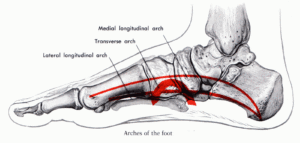Originally published on
https://nwfootankle.com/foot-health/drill/2-articles/113-arch-support
In order to understand the treatment of rendering an arch support, one must understand the architectural principle of an arch, and liken that principle to the multitude of arches that naturally occur in the human foot. When you study the structure of the foot and the shapes of the bones of the foot, you quickly realize that most of the weightbearing bones of the foot, are indeed arches themselves by being shaped to have support ends at either end of the bone and an open space or boney arch in between the support ends of the bones.
For the purposes of the current discussion, we will concentrate on what might be considered one of the primary arches of the foot, sometimes called the medial (inside of the foot) longitudinal arch, the arch that spans between the rearfoot or heel bone and the forefoot or ball of the foot and toes.
Webster’s dictionary defines an arch as “a curved structure that supports the weight of material over an open space.” Said another way, an arch is a structure that is able to support weight over an open space, by providing support on either end of that open space.
Applying this logical definition to the arches of the foot necessitates support on either end of the arch, and is exactly the opposite of the type of “arch support” that is available to consumers, either over the counter (i.e. Dr. Scholl’s or similar product), or from their healthcare professional (footbed, arch support, orthotic). These products attempt to “support” the arch, not by supporting the ends of the foot arch, but rather by lifting up under the open space of the foot arch. This does not make sense.
True support of the arches of the foot would suggest that the ends of the arches, on either end of the foot’s open space are the structures to be supported. This would mean that the heel and the forefoot joints (metatarsophalangeal joints and interphalangeal joints) are the structures that should be supported, and not the structures in between the ends of the arch.
Current footwear available to consumers is improperly positioning the support ends of the arch, by elevating the heel, which is one end of the arch, and unnaturally pinching the toes and holding them above the ball of the foot (metatarsophalangeal joints), which is the other end of the foot arch.
True support of the foot arch would then necessitate getting the heel bone (calcaneus) flat on the ground to provide support for the rearfoot support end, as well as getting the toes flat on the ground as well, so that the toes can help the ball of the foot to provide support for the other end of the foot arch in the forefoot.
Individuals who grow up barefoot, naturally have the support they need for both ends of their foot arch, and this is likely part of the reason why their foot arches function perfectly throughout their lifetimes, and their feet do not break down, unlike 80% of Americans who by nature of their habitual shoe wearing and compromised arches, will suffer some form of foot problem at some point in their lives.
This is not to suggest that we should all ditch our shoes and begin walking around barefoot, but it does suggest that our shoes are made improperly and are the cause of the arch problems and the associated deformities that many Americans experience. Read more
Dreamclinic is a Health and Wellness company committed to sharing information about commonly experienced health conditions and how they may be impacted through the use of bodywork and other natural approaches. Dreamclinic offers massage, acupuncture, and Reiki sessions at its Greenlake and Queen Anne clinics, as well as onsite massage at workplaces around Puget Sound. Contact us to learn more about how Dreamclinic can help you, your family or your workplace experience greater health.
Original article:
https://nwfootankle.com/foot-health/drill/2-articles/113-arch-support
Reposted with permission of the author.
Image: www.posturologyblog.com

